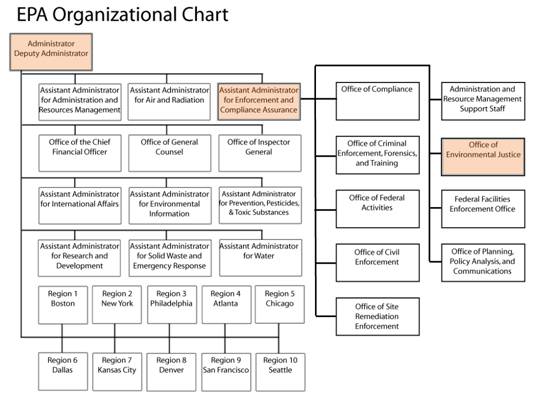 |
 |
 |
 |
United States Environmental Protection Agency on EJ
|
|---|
This page outlines Executive Order 12898 and what the Environmental Protection Agency (EPA) has done to address EJ. |
|---|
Executive Order 12898
President Clinton signed Executive Order 12898 (EO12898) in 1994 with the following goal: Each Federal agency shall make achieving environmental justice part of its mission by identifying and addressing, as appropriate, disproportionately high and adverse human health or environmental effects of its programs, policies, and activities on minority populations and low-income populations.
The EPA is charged with convening a working group of federal agencies that will coordinate EJ efforts, provide guidance to all federal agencies in identifying situations of environmental injustice, and ensure that EJ actions by each federal agency are consistent.
EO12898 clearly specifies responsibilities and areas of focus for EJ efforts:
1. Federal agencies must not exclude any person or groups of people from participating in or benefiting from any programs, policies, or activities that affect human or environmental health.
2. Public participation and access to information must be ample and appropriate.
3. Research and data collection should: include diverse and high-risk segments of the population; identify populations with multiple and cumulative exposures to risk; identify populations who rely on consumption of fish and wildlife for subsistence; and identify populations by race, national origin, and income to determine disproportionate risk on minority and low-income populations.
See the full text of EO12898 here.
EPA Organization of EJ Efforts
The EPA headquarters is organized under one Administrator, who directs 12 main departments. The United States is divided into 10 regions, each of which is represented by a regional office. Below is the EPA organizational chart highlighting the location of EJ offices.
New York City is in Region 2; http://www.epa.gov/region2/.
One of the most progressive regions is Region 9, which includes California; http://www.epa.gov/region09/.
EPA homepage: http://www.epa.gov/
EPA organization chart webpage: http://www.epa.gov/epahome/organization.htm

Office of Compliance and Enforcement
Directs EJ actions within the EPA.
Pursues enforcement and provides compliance assistance in areas that yield the most environmental benefit or reduce risk to human health.
http://www.epa.gov/compliance/index.html
Office of Environmental Justice
EPA’s national office. Directed by the Office of Compliance and Enforcement. Created in 1992.
Three main areas of focus: Policy Development and Inter/Intra-Agency Coordination; Outreach; and Administration and Resources Management.
Contains an Executive Steering Committee representing the EPA headquarters office and the 10 regional offices.
http://www.epa.gov/compliance/about/offices/oej.html
http://www.epa.gov/compliance/environmentaljustice/index.html
National Environmental Justice Advisory Council (NEJAC)
Directed by the Office of Environmental Justice. Created in 1993.
Contains a federal committee that makes EJ recommendations to the EPA.
Designed to represent a wide range of stakeholders and create innovative solutions to EJ problems.
http://www.epa.gov/compliance/environmentaljustice/nejac/index.html
Federal Interagency Working Group on Environmental Justice
Established under EO12898. Created in 1994.
Comprised of 11 federal agencies and several White House offices.
Works to integrate EJ into individual agency and office programs.
http://www.epa.gov/compliance/environmentaljustice/interagency/index.html


